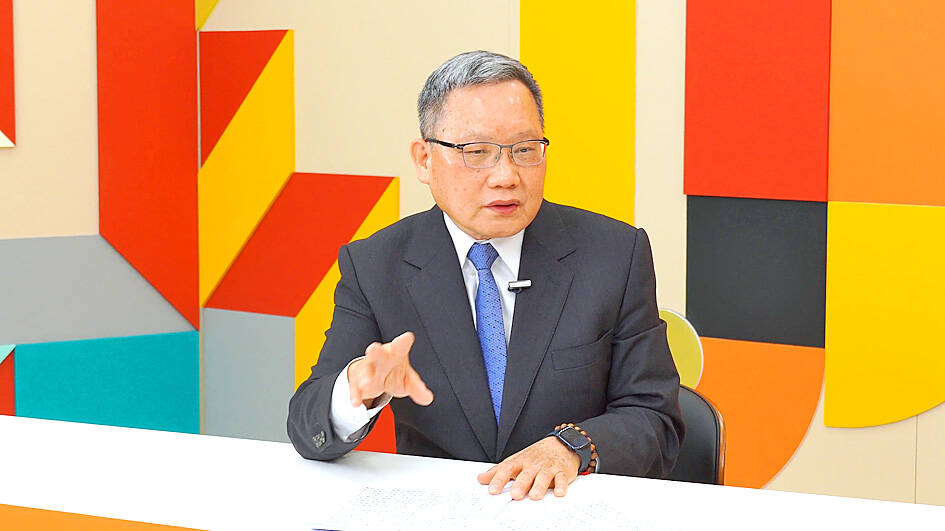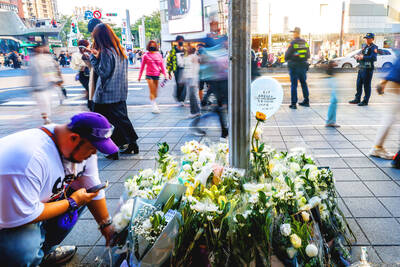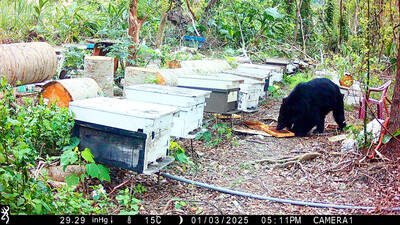Taiwan could benefit from the reorganization of global supply chains due to its democratic government, Taiwan Academy of Banking and Finance president Su Jain-rong (蘇建榮) said.
Wu made the remarks in an interview with the Chinese-
language Liberty Times (the sister paper of the Taipei Times) that was posted online yesterday.

Photo: Chen Yu-jui, Taipei Times
Citing Academia Sinica member Cyrus Chu’s (朱敬一) book Ultimate Economic Conflict between China and Democratic Countries: An Institutional Analysis (價值戰爭:極權中國與民主陣營的終極經濟衝突), Su said that the global supply chain is, by and large, being restructured along the lines of the democratic and autocratic camps.
Following the US-China trade war and COVID-19 pandemic, many companies have pulled out of China and relocated supply chains to other countries, he said.
The restructuring effort, headed by the US, does not imply desinicization, he said, adding that it aims to promote “ally-shoring,” the relocation of manufacturing plants from China to other countries — mainly democratic and free ones.
Su cited the US-Taiwan Initiative on 21st Century Trade bill signed by US President Joe Biden in August last year as an example of “ally-shoring,” saying that Taiwanese businesses sending products to the US, of which manufacturing plants were previously based in China, have relocated these plants to Mexico under the restructured supply chain.
Taiwan’s small and medium-sized enterprises (SMEs) provide greater vitality and flexibility in investing compared with larger corporations, he said, adding that these SMEs could play an essential role in the global supply chain.
Countries in the Americas and Europe had hoped that China would begin to dial back authoritarian rule after an improvement of its economy following its inclusion in the WTO in 2001, but Beijing ended up “stealing” democratic countries of their intellectual properties and other technologies after becoming an economic powerhouse, Su said.
With Chinese President Xi Jinping (習近平) adopting a heavy-handed political approach, foreign companies are hesitant to continue investing in China, resulting in a shrinking production sector, reduced jobs and lower consumption, Su said.
China’s public and private-sector debt has reached 200 percent of its GDP over the past few years.
Local government debt is primarily due to real-estate bubbles and the inability to repay its debts has affected China’s overall financial system, Su said.
The People’s Bank of China is making a large amount of funds available in hopes that financial institutions would have sufficient capital on hand and avoid potential financial storms, he said.
Information opacity in China is another concern, as the nation’s issues could be severe and catch its neighbors off guard, he added.

SHIPS, TRAINS AND AUTOMOBILES: The ministry has announced changes to varied transportation industries taking effect soon, with a number of effects for passengers Beginning next month, the post office is canceling signature upon delivery and written inquiry services for international registered small packets in accordance with the new policy of the Universal Postal Union, the Ministry of Transportation and Communications said yesterday. The new policy does not apply to packets that are to be delivered to China, the ministry said. Senders of international registered small packets would receive a NT$10 rebate on postage if the packets are sent from Jan. 1 to March 31, it added. The ministry said that three other policies are also scheduled to take effect next month. International cruise ship operators

HORROR STORIES: One victim recounted not realizing they had been stabbed and seeing people bleeding, while another recalled breaking down in tears after fleeing A man on Friday died after he tried to fight the knife-wielding suspect who went on a stabbing spree near two of Taipei’s busiest metro stations, Taipei Mayor Chiang Wan-an (蔣萬安) said. The 57-year-old man, identified by his family name, Yu (余), encountered the suspect at Exit M7 of Taipei Main Station and immediately tried to stop him, but was fatally wounded and later died, Chiang said, calling the incident “heartbreaking.” Yu’s family would receive at least NT$5 million (US$158,584) in compensation through the Taipei Rapid Transit Corp’s (TRTC) insurance coverage, he said after convening an emergency security response meeting yesterday morning. National

PLANNED: The suspect visited the crime scene before the killings, seeking information on how to access the roof, and had extensively researched a 2014 stabbing incident The suspect in a stabbing attack that killed three people and injured 11 in Taipei on Friday had planned the assault and set fires at other locations earlier in the day, law enforcement officials said yesterday. National Police Agency (NPA) Director-General Chang Jung-hsin (張榮興) said the suspect, a 27-year-old man named Chang Wen (張文), began the attacks at 3:40pm, first setting off smoke bombs on a road, damaging cars and motorbikes. Earlier, Chang Wen set fire to a rental room where he was staying on Gongyuan Road in Zhongzheng District (中正), Chang Jung-hsin said. The suspect later threw smoke grenades near two exits

The Forestry and Nature Conservation Agency yesterday launched a gift box to market honey “certified by a Formosan black bear” in appreciation of a beekeeper’s amicable interaction with a honey-thieving bear. Beekeeper Chih Ming-chen (池明鎮) in January inspected his bee farm in Hualien County’s Jhuosi Township (卓溪) and found that more than 20 beehives had been destroyed and many hives were eaten, with bear droppings and paw prints near the destroyed hives, the agency said. Chih returned to the farm to move the remaining beehives away that evening when he encountered a Formosan black bear only 20m away, the agency said. The bear